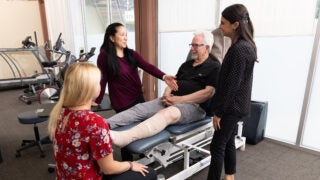
Californians support teachers, schools but accountability concerns remain
The fifth annual PACE/USC Rossier poll finds that voters’ perceptions of local public schools have reached the highest level of confidence since the poll began.
Californians are showing an increased faith and optimism in local public schools and teachers but believe there is room for improvement, according to results of the fifth annual PACE/USC Rossier School of Education poll.
Twenty-three percent of Californians believe that their local public schools have “gotten better” over the past few years while 35 percent believe they have “stayed the same,” the poll showed. Thirty percent said their local schools have “gotten worse.” When the same question was asked four years ago, only 11 percent said schools had gotten better and 45 percent said schools had gotten worse.
“Californians are clearly noting some progress in our schools, particularly when asked about local schools. This is positive,” said Morgan Polikoff, associate professor of education at the USC Rossier School of Education and a researcher for the poll. “The question is whether that progress is real and whether it will be sustained. Are kids better off? These will be important issues to watch as new school accountability systems required under the federal Elementary and Secondary Education Act are implemented.”
California voters’ views of their local schools stand in contrast to national trends. While recent national polling has shown that the public’s view toward local schools has not appreciably changed since 2000, Californians are reversing that trend by becoming more positive about their local schools.
The results also contain encouraging signs for the teaching profession: 71 percent of voters said they would encourage a young person to go into teaching, and 90 percent cited the ability of teachers to make a difference in children’s lives.
“Counter to the dominant narrative we’ve been hearing for some time, these results indicate widespread respect for and recognition of the value of the teaching profession,” said Julie Marsh, a co-director of Policy Analysis for California Education (PACE), researcher for the poll and an associate professor of education at USC Rossier.
What about salary and compensation?
The sticking point for those who would not encourage young people to become teachers? Salary and compensation. Voters expressed major reservations about low teacher salaries. More than 70 percent of voters who wouldn’t recommend becoming a teacher indicated that salary or compensation contributed to their position.
On how to address the compensation issues, voters were less clear. Across the board, they showed enthusiasm for paying teachers more. They said they supported higher pay for all teachers, higher pay for those who work in schools serving large numbers of disadvantaged students, and higher pay for teachers if they are instructors for subjects that often face shortages, such as science, technology, engineering and math, and special education.
“It is always hard to ask about tradeoffs in polls, and the issue of teacher pay is a major area where tradeoffs matter,” Polikoff said. “Increasing teacher pay is a fine policy option, but it’s also very expensive. Teacher pay is by far the biggest contributor to educational spending.”
Another concern: While voters expressed support for pay increases, especially as a way to address teacher shortages, more respondents expressed support for reforming school operations (26 percent) than for increased funding (15 percent), and a majority (58 percent) favored a combination. On top of that, many respondents said they believed there is room for teachers to improve, with voters indicating that at least a third of California teachers need support to improve.
The PACE/USC Rossier poll was conducted Aug. 23-30 by Tulchin Research and Moore Information and surveyed 1,202 registered California voters. The poll was conducted online and allowed respondents to complete the survey on a desktop or laptop computer, tablet or smartphone. The poll was conducted in English and Spanish. The margin of error for the survey is +/- 2.83 percentage points.



